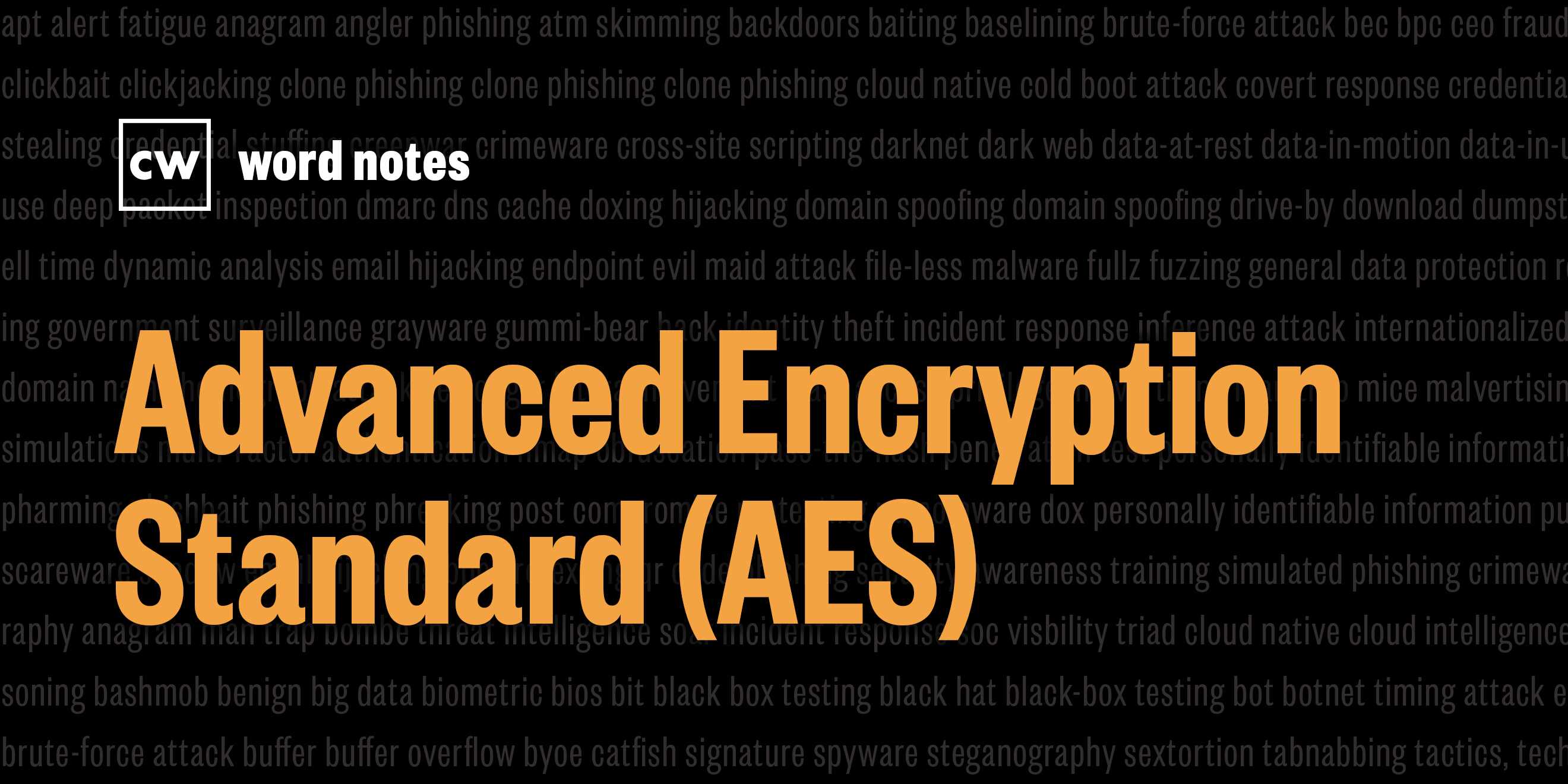
Advanced Encryption Standard (AES) (noun)
Rick Howard: The word is: AES
Rick Howard: Spelled: A for advanced, E for encryption and S for standard.
Rick Howard: Definition: A U.S. Government specification for data encryption using an asymmetric key algorithm.
Rick Howard: Example sentence: AES was developed by the National Institute of Standards and Technology or (NIST) in 2001, and established a standard by the U.S. Federal Government in 2002.
Rick Howard: Origin and context: Every time I revisit this subject of encryption, I always feel like I have to relearn the definitions again. My senior moment brain can't seem to keep them all straight. In a nod to one of my favorite superhero movies of all times, Spiderman into the Spiderverse, when all the multidimensional spider people take turns explaining their origin story by saying, " All right, let's do this one last time."
Rick Howard: Let's do this one last time for cryptography. The art and science of code making. Encryption converts plain text into an unrecognizable form using the codes that cryptographers make. Signing, uses trap door or mathematical, one way functions from cryptography for non-repudiation. In other words, signed messages or file authors can't deny that they signed it, and it's mathematically impossible for a third party to forge a signature.
Rick Howard: Keys, a string of characters used within a cryptographic function to transform plain text into cypher text or back. Like a physical key, it locks data so that only someone with the right key can unlock it. Cryptoanalysis the reverse of cryptography. It's all the things you do to break the codes like Alan Turing, using Bayes' Rule to break the German enigma coding machines in World War II and just to make things more confusing, cryptology captures both disciplines, cryptography and cryptoanalysis.
Rick Howard: The cryptography idea has been around since the world was young. According to the fails group, the Spartans around 600 BC used a device called a scytale to code plain text into encrypted messages. In order for their Spartan friends to decode the messages on the other side, they needed an identical scytale tail in terms of width and length. By 60 BC the Romans used a simple substitution cipher where they encoded messages by shifting the letter by some agreed upon number.
Rick Howard: For example, if the number was three, the plain text of the letter A becomes an encoded letter D. The plain text B becomes an encoded E, and so forth. Fast forward to 1553, Giovan Battista Bellaso introduce the idea of a secret key or password that two parties would need to encrypt and decrypt messages. If Fred and Ginger wanna exchanged secret messages, they both would have to have the secret key. Fred would encode the message with the key, and Ginger would decode it with the same secret key.
Rick Howard: By 1917, an American named Edward Hebern had invented the electro-mechanical machine . In which the key was embedded in a rotating disc. The next year, 1918, German engineer Arthur Scherbius invented the Enigma machine using more than one rotor and the German military adopted it to send coded transmissions during World War I in World War II. By the 1970s, IBM invented a block cipher instead of using multiple letters as the enigma rotors did, the key is an entire block of text. The U.S. Government adopted this model, the IBM data encryption standard, or DES, DES in 1973 and used it until it was broken in 1997.
Rick Howard: In 1976, Whitfield Diffie and Martin Hellman created the Diffie-Hellman key exchange, making it possible to send encrypted messages without having to share a secret key beforehand. This was huge. It's called asymmetric encryption, and it's the main idea behind all modern day web transactions. There is a public key that anybody in the world can use to encrypt a message to Ginger, but Ginger is the only one that has the secret key that can decrypt any messages sent to her with the public key. The two keys, public and secret, are mathematically linked, but it's computationally impossible to use the public key to read the encrypted message.
Rick Howard: The next year, 1977, the team of Ron Rivest, Adi Shamir, and Leonard Aldeman, RSA, created the first working algorithm of the Diffie-Hellman key exchange. By 2000, the advanced encryption standard or AES replaced DES as the standard by being faster and having the ability to use much longer keys.
Rick Howard: Nerd reference: You're listening to the classic Clair De Lune, that's French for moonlight, written by French composer Claude Debussy, and published in 1905.
Rick Howard: And it just happens to be some of the background music used in a fantastic little first person computer game called CYPHER. That's C Y P H E R, where you walk through a Museum of Cryptology and solve the multiple puzzles provided in various forms of cryptoanalysis: Steganography, transposition, mono alphabetic substitution, poly alphabetic substitution, mechanized cryptography, and digital cryptography. I got as far as the first puzzle before I got stumped, but hey, this might be your thing.
Rick Howard: Word notes: is written by Tim Nodar, executive produced by Peter Kilpe and edited by John Petrik and me, Rick Howard. The mix, sound design, and original music have all been crafted by the ridiculously talented Elliott Peltzman. Thanks for listening.

